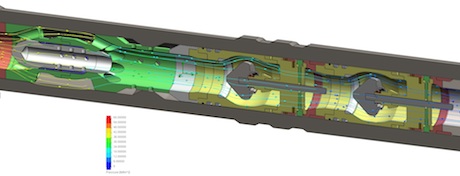Churchill’s self filling float provides barrier on demand
 An innovative self-filling float from Churchill Drilling Tools, which provides an effective barrier on demand, reduces costly intervention and combats pressure surge is set to enhance global drilling practices following successful deployments in the North Sea.
An innovative self-filling float from Churchill Drilling Tools, which provides an effective barrier on demand, reduces costly intervention and combats pressure surge is set to enhance global drilling practices following successful deployments in the North Sea.
The self-filling float is being used by two major operators in varied applications in the region, and the company has seen further significant interest in the tool on a worldwide basis.
Floats in the bottom hole assembly (BHA) play a critical role in protecting the rig from uncontrolled hydrocarbons in the formation, but running into hole (RIH) with a float, or non-return valve (NRV), can be inconvenient because of a lack of flexibility in deployment.
Churchill’s patent pending Self-Filling Float allows the operator to select the timing of float activation. By using the float rapid, surge-free RIH can be achieved before activation puts it into a fully protected mode, providing two high quality non-return barriers between the rig and the formation.
The tool, which is resistant to 350°C (660°F), allows the string to self-fill whilst RIH, saving 30%-50% on time spent tripping into hole compared to regular floats. Formation damage from RIH surge pressures can be avoided with the float in the open position and full pumping capability is retained at all times
A steel dart is dropped whilst the final few stands are RIH. A pressure cycle activates the float and stores the dart in the core chamber. Optimised internal geometries and high durability surface finishes ensure pressure loss is minimal and the float can handle any anticipated flow rate.
In the self-filling dormant mode, the floats remain open through use of retaining pins, allowing filling as the BHA is run in hole. Pumping is possible without risk of activating the tool, allowing shallow hole tests to be performed with no danger of the floats becoming inadvertently activated.
At the appropriate time, the dart is dropped into place. When the pumps are turned on pressure immediately rises as the dart presses down on the seat. The float assembly pins shear at close to 200 psi, releasing the retaining pins, and as the floats become active they immediately close.
The dart continues to experience increasing pressure until its sleeve pins shear, allowing it to fall towards the storage core, where it forms a low profile centralised ‘bullet’ around which flow can pass freely past the floats and onto the bit.
Churchill Drilling Tools’ director Mike Churchill said: “The aim of a float is to create an effective safety barrier for the rig within the drillpipe, and, while we all welcome anything that increases safety, traditional floats do have operational drawbacks. They can require a top-filling intervention when they create a vacuum in the pipe, and they will also add to surge pressure on the formation.
“The self-filling float is an effective and practical solution. It enables operators to comply with safety requirements yet gives them the choice of when to activate. It has been deployed this year by some of the leading names in the oil and gas industry with excellent feedback. In addition to the time and formation protection savings, rig-floor feedback has also been very positive as eliminating top-filling has also removed spillage and created a cleaner and safer working environment whilst running in hole, so we expect more success for the tool in the future.”






